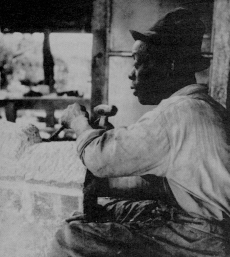 Born around
1870 in the Hillsboro Road section of Nashville to "foreparents [George
and Jane] who were Edmondson and Compton slaves," William Edmondson
was one of six children reared by his mother after the death of their father.
Born around
1870 in the Hillsboro Road section of Nashville to "foreparents [George
and Jane] who were Edmondson and Compton slaves," William Edmondson
was one of six children reared by his mother after the death of their father.
After many years of working for the Nashville, Chattanooga, and St. Louis Railroad and the Women's Hospital (Baptist Hospital), Edmondson entered the art world by divine command, according to an article in the Nashville Tennessean: "While he lay asleep, God appeared at the head of his bed and talked to him, like a natural man, concerning the talent of cutting stone He was about to bestow. He talked so loud He woke me up. He told me He had something for me." Edmondson was instructed to make chisels and other sculpting tools.
This primitive artist, who began his career by working on tombstones, worked exclusively in limestone, usually from demolished city buildings and curbs from rebuilt streets. Wrecking companies often diverted their trucks to Edmondson's backyard to leave piles of stone at lime or no cost. During fifteen years or more of sculpting, his backyard became filled with "miracles" that were not tombstones but preachers, women, doves, turtles, angels, rabbits, horses, and other "critters" and "miracles."
Five years after he began to sculpt in limestone, Edmondson's competence in art was acknowledged by the art world. Sidney Hirsch, Alfred and Elizabeth Starr, and Louise Dahl-Wolfe were instrumental in uncovering Edmondson's gift of sculpting stone. Dahl-Wolfe, a photographer for Harper's Bazaar magazine, brought Edmondson to the attention of Alfred Barr, the director of the Museum of Modern Art. Barr and some of the trustees expressed interest in a type of painting and sculpture they classified as "modern primitive" and which they applied to Edmondson's art. Thus, Edmondson became the first black American to be accorded a one-man show at the Museum of Modern Art.
Edmondson soon was widely recognized and honored for his sculpture. In 1938, his sculpture was included in "Three Centuries of Art in the United States." On February 11, 1941, he was honored with a one-man show at the Nashville Art Gallery. In 1951, Edmondson was posthumously honored by the Nashville Artist Guild. Edmondson's pieces were included in other exhibitions: Nashville's Peabody College (1951); New York's Willard Gallery; Cheekwood (Tennessee Botanical Gardens and Fine Arts Center) and Lyzon Galleries in Nashville (1964); City College of New York and the LaJolla Museum of Contemporary Art (1967); Willard Gallary and Newark Museum (1971); and a one-man show at the Monteclair Art Museum in 1975. The June, 1981, opening of the Tennessee State Museum featured an exhibition and illustrated catalogue of Edmondson's sculptures.
Poor health caused Edmondson to cease sculpting in the late 1940s. On February 7, 1951, he died and was buried at Mount Ararat Cemetery in Nashville. In June, 1979, a park at Seventeenth Avenue, North, and Charlotte Avenue was named in honor of Edmondson. On July 8, 1981, a marker of limestone, which came from the old Commerce Union Building, was unveiled. Sculptor Gregory Ridley carved a dove into the block, above the accompanying inscription: This park is dedicated to the memory of the renowned Nashville sculptor, William Edmondson.